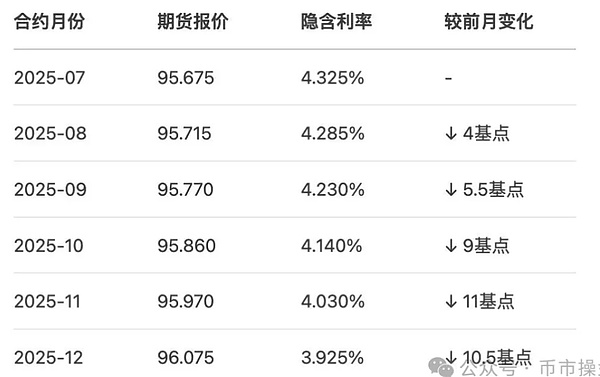On June 6, boosted by the mild cooling of the labor market, the Nasdaq index jumped 1% and Bitcoin soared more than 3%. Both of them got rid of the drag of Trump and Musk's "Twitter fight". Within two days of the release of ADP and non-farm data, Trump called on Powell to cut interest rates as soon as possible on social media for four times in a row. Although Powell still turned a blind eye to Trump's call, the "rate cut trade" has quietly become one of the hottest themes at the moment.
According to the pricing of federal interest rate futures, the market expects the Federal Reserve to cut interest rates by 45 basis points in the second half of the year (the median expectation is 25 basis points in September and December), of which the probability of the first rate cut at the September FOMC meeting is 58% = (5+4+5.5)/25. It is worth noting that the CME FedWatch tool shows a stronger expectation of easing - the indicator shows that the probability of at least a 25 basis point rate cut in September has risen to 62.4%, indicating that some traders are betting on earlier and more aggressive easing policies.

The important reason why the market pays special attention to the first rate cut is that according to historical backtesting since 1990, the average cumulative rate cut within 12 months after the first rate cut by the Federal Reserve reached 175 basis points. The current interest rate futures pricing shows that from September 2025 to December 2026, the federal funds rate will be reduced by 125 basis points in total, which means that the first rate cut is equivalent to the start of a new round of easing cycle.
Historically, the decline in interest rates has usually been a catalyst for the strength of small-cap stocks and altcoins. According to Jefferies data, since 1950, after the first interest rate cut by the Federal Reserve, the average increase of small-cap stocks in 3, 6 and 12 months was 11%, 15% and 28%, respectively, which was higher than the 5%, 10% and 15% of large-cap stocks. The main reasons for the better performance of small-cap stocks are as follows:
1. Compared with large companies, small companies generally have higher debt levels. Interest rate cuts help reduce borrowing costs, which means reduced financial costs and higher profit margins for small companies that rely on bank loans and floating rate debt.
2. The downward trend in interest rates has reduced the attractiveness of fixed-income financial products such as bonds and bank deposits, thereby driving funds to high-risk and high-yield assets, ultimately leading to a continuous increase in market risk appetite.

Therefore, from July to August 2025, the Russell 2000 Index and altcoins will still strengthen again. However, it should be emphasized that the essence of this round of altcoin market is still an oversold rebound, and its intensity is likely to be weaker than the two large-scale rebounds in 2024 (in March 2024, the median increase of the top 100 currencies by market value was 376%; in November 2024, the median increase was 404%). In a market with increasing token dumping supply and institutionalization, it is almost difficult to reproduce the "altcoin season". In a sense, the biggest role of the altcoin rebound is to provide an opportunity for historical locked-in positions to exit calmly.
In terms of target selection, stablecoins are undoubtedly the direction with the highest certainty at the moment. On June 6, 2025, the intraday stock price of Circle, the "first stock" of stablecoins, once reached $123, a nearly 300% increase from the IPO issue price of $31. Although its circulating market value once exceeded $28 billion, Circle's net profit for the whole year of 2024 was only $156 million. Such a high valuation premium largely reflects the market's high recognition of the long-term development prospects of stablecoins and RWA tracks.
On April 30, 2025, the U.S. Treasury Borrowing Advisory Committee (TBAC) submitted a report to the U.S. Treasury Department showing that the market value of stablecoins will increase from approximately US$234 billion in April 2025 to US$2 trillion in 2028, an increase of approximately 8.3 times. As the most important infrastructure for stablecoins, Ethereum currently has a market share of 55%, and stablecoin transactions account for 35%-50% of Ethereum's fee income. Assuming that this ratio remains unchanged and the transaction volume is proportional to the market value growth, Ethereum's stablecoin-related fee income in 2028 may increase by 5-7 times, that is, US$12 billion to US$16.8 billion.
In addition, Ethereum's market share in the tokenization market is as high as 81%. If the RWA market size grows from the current tens of billions of dollars to trillions of dollars, Ethereum, as the main settlement layer, can also obtain considerable fee income. In other words, after the GENIUS stablecoin bill is passed, the first project to be revalued should be ETH.
 Weatherly
Weatherly



